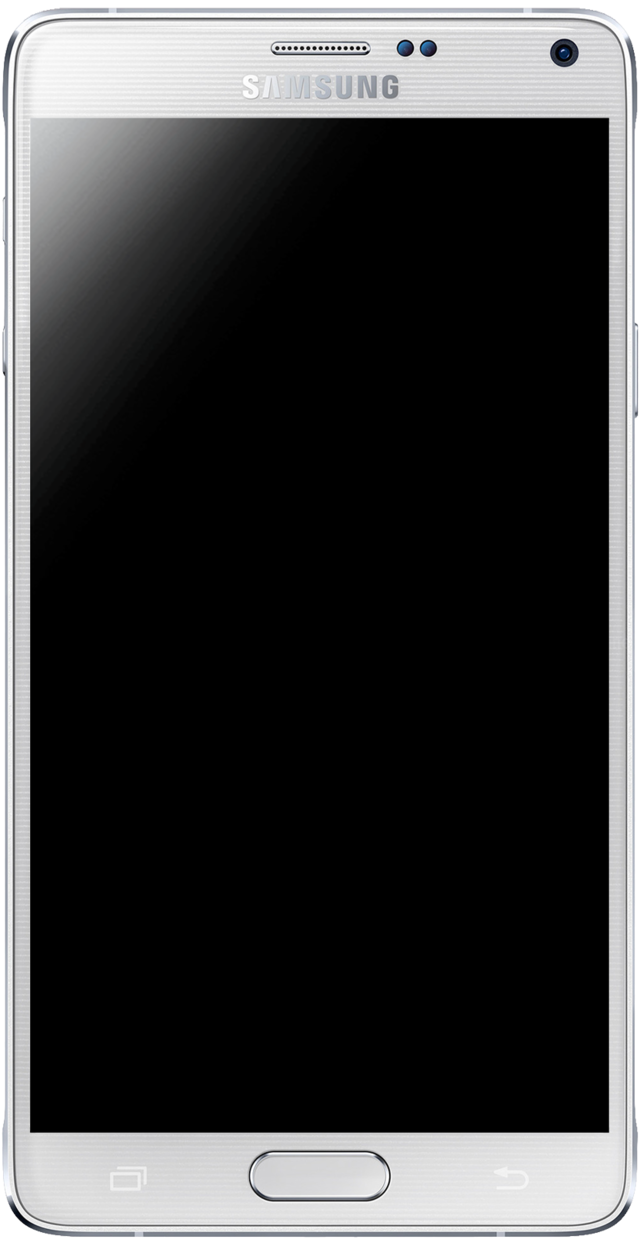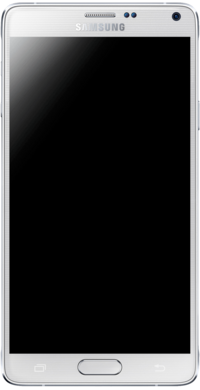Samsung Galaxy Note 4
Contributors to Wikimedia projects
 Article Images
Article Images
The Samsung Galaxy Note 4 is an Android phablet smartphone developed and produced by Samsung Electronics. The Galaxy Note 4 was unveiled during a Samsung press conference at IFA Berlin on 3 September 2014 and was released globally in October 2014.[1] It serves as the successor to the Samsung Galaxy Note 3.
 | |
 Samsung Galaxy Note 4 in White | |
| Manufacturer | Samsung Electronics |
|---|---|
| Slogan | Do You Note? |
| Series | Galaxy Note |
| Availability by region |
|
| Predecessor | Samsung Galaxy Note 3 |
| Related | |
| Type | Phablet |
| Form factor | Slate |
| Dimensions | 153.5 mm (6.04 in) H 78.6 mm (3.09 in) W 8.5 mm (0.33 in) D |
| Weight | 176 g (6.2 oz) |
| Operating system | Android 4.4.4 "KitKat" Current: Android 5.0.1 "Lollipop" Planned: Android 6.0.1 "Muffin" |
| System-on-chip | Samsung Exynos 7 Octa 5433 64-bit (LTE Cat.4 & South Korea LTE CAT.6 & LTE CAT.9 version) Qualcomm Snapdragon 805 (LTE Cat.6 version) |
| CPU | Quad-core 1.3 GHz Cortex-A53 & Quad-core 1.9 GHz Cortex-A57 or 1.3 GHz Octa Core Cortex-A53 (Exynos version) Quad-core 2.7 GHz Krait 450 (Snapdragon version) |
| GPU | ARM Mali T760 (Exynos version) Adreno 420 (Snapdragon version) |
| Memory | 3 GB LPDDR3 |
| Storage | 32 GB flash memory (Global) 16 GB flash memory(China Variant) |
| Removable storage | microSDXC up to 128 GB |
| Battery | Removable Li-Ion 3,220 mAh(Global) Li-Ion 3,000 mAh(China Variant) |
| Display | 5.7" (145 mm) Quad HD Super AMOLED (16:9 aspect ratio) 2560×1440 pixel resolution, 515 ppi |
| Rear camera | 16 MP, f2.0, 1/2.6" sensor, with autofocus, OIS, and 4K video recording (Sony IMX240) |
| Front camera | 3.7 MP, f1.9 |
| Connectivity | |
| Data inputs | List
|
| Development status | Released |
| Website | Official website |
Specifications
Hardware
The Samsung Galaxy Note 4 features a 2560×1440 Quad HD (QHD) WQ HD Super AMOLED 5.7-inch display with damage-resistant Gorilla Glass 4, and provides a pixel density of 515 ppi (pixels-per-inch) The Note 4 comes in two variants, one powered by a 2.7 GHz quad-core Snapdragon 805 chipset with Adreno 420 GPU, the other powered by Samsung’s ARMv8-A Exynos 7 Octa SoC with two clusters of four cores; four Cortex-A57 cores at 1.9 GHz, and four Cortex-A53 cores at 1.3 GHz, which is the same processor cluster sold for the Samsung Galaxy Note 3 in markets that mostly use or only have 3G (Such as HSUPA & HSPA), and/or '2G', such as unaltered GSM and CDMA networks, similar to how the Galaxy Note 4 is sold. China Mobile Plus Network TD-SCDMA & TD-LTE
Both devices that use 4G, LTE/LTE-A & Hybrid 4G-LTE Networks are currently only sold in Canada, Australia, U.S, U.K (For some carriers), Sweden, Norway, Denmark, and South Korea, which have wide spread 4G LTE Markets, or are solely 4G/LTE/LTE-A dependant such as Canada & Denmark, which do not use any 3G or older networks, except for HSUPA (Used as a fall back network should the signal strength be weak due to being underground or in the middle of a building), as well as HSPA+, which is a 3G network, though considered by some to be the Original 4G.[2][3][4] The GPU in charge in the Exynos chipset is the Mali-T760.[5] Both variants come with 3GB of LPDDR3 RAM and 32GB of internal memory.[6] Samsung touted new S-Pen features including tilt and rotation recognition[7] but these features are either not implemented or not supported.[8] The Note 4's back-cover has a strong resemblance to the Note 3, with a faux leather texture (although without the simulated stitching). Note 4 has a new aluminum frame design, bearing resemblance from the Samsung Galaxy Alpha. Criticism has been aimed at the lack of IP67 certification (water and dust resistance), which is present in Samsung's other flagship, the Galaxy S5.
The Note 4 features a USB 2.0 charging port instead of USB 3.0 (as was in the Note 3 and S5), in favor of a new feature called Fast Charge, which Samsung claims can charge the phone from 0% to 50% in about 30 minutes and from 0% to 100% in less than 100 minutes. It features some unique sensors such as a UV sensor and heart-rate monitor, among other, more common sensors.
The Note 4 also includes a stylus pen seamlessly incorporated into the design.
Software
The Samsung Galaxy Note 4 comes with Google's mobile operating system, Android, specifically KitKat 4.4.4, with its user interface modified with Samsung's custom skin named TouchWiz Nature UX 3.0. The Note 4 contains most of the original Note's software features and functions, but also adds more significant upgrades from the predecessors, such as a new multitasking interface, expanded S-Pen functions, and gestures and refreshed menus and icons.
The device can be updated to Android 5.0.1 Lollipop in many regions. This update brings a new, refined UI and features a new runtime. The update has been criticized for poor battery life.
Camera
The main (rear-facing) camera is a 16 MP autofocus camera, featuring Smart OIS (Optical Image Stabilization + software image stabilization). 4K video recording at 30fps and 1080p video recording at 60fps and 120fps (Smooth Motion) and also it has 120fps slow motion video recording in 720p resolution. The secondary (front-facing) camera is a 3.7 MP camera with an f1.9 aperture that can record 2560x1440 QHD videos and capture wide-angle pictures.
Variant
IFA 2014 published immediately after Samsung Electronics announced the launch would take place in October 2014 into the world. After that, the micro site has been launched in countries such as Samsung Electronics is the state waiting for the launch site.
Device name seems to have been settled in a format that is classified according to regions and carriers that are released in formats that are classified according to the mobile communications to support this. By default, the name and the SM-N910 two weeks, SM-N916 supports the LTE Cat.9 model name and can identify the availability region and carrier in accordance with the alphabet and numbers behind the device name suffix. However, and it takes alot F model is launched in Africa depending on the market circumstances, including but not 100% fit for all the C model released in Europe. In addition, it states that the suffix in the alphabet below the suffix is added to the Q refers to the Turkish market model.
By default, devices that suffix S / K / L / U / C / H is the device name is eksi North 7 Octa (5433) suffixes are devices other than the alpha or numeric bell is mounted, and is equipped with a Qualcomm Snapdragon 805 APQ8084. The model has many things to look at snapshots of rooms, North America and is looking to tighten the results given by the equipment name as a separate carrier in China.
Samsung Exynos AP Variant
| S-Korea SK Telecom | K-Korea KT | L-Korea LG U+ | U- standard LTE Cat.6 | C- standard LTE Cat.4 | H- standard WCDMA |
Qualcomm Snapdragon AP Variant
| W8-Canada | V-U.S Verizon | P-U.S Sprint | A- U.S AT&T | T-U.S T-Mobile US | R4-U.S US Celluar |
| 0-China Open Variant | 6-China China Unicom | 8-China China Mobile | 9-China China Telecom | G- Indian Ocean | F- universal model |
Sales
Samsung Galaxy Note 4 was released around the start of October 2014, and was available in most major markets by the middle of October. The first regions to receive the device were South Korea and China where it has gained huge popularity. In the first month only, the Galaxy Note 4 has reportedly sold 4.5 million units, which is a little less than its predecessor, the Galaxy Note 3, which was able to report 5 million sales in the first month after release.[9][10] Samsung says that sales of the Note 4 were lower than those of the Note 3 at launch because the Note 4 was initially unavailable in some major international markets due to manufacturing issues, delaying release until early November in markets including the United Kingdom and India.
Plug-in for Samsung Gear VR
Only specific Snapdragon chipset variants of the Samsung Galaxy Note 4, sold by some of US mobile carriers, may be plugged into the Samsung Gear VR headset, which was created in partnership with Oculus VR.[11]
Reception
DisplayMate, when the Note 4 was released in late 2014, measured the performance of the display and said it was the best performing smartphone display ever tested and raised the bar for display performance.[12]
See also
References
- ^ Rubin, Ben Fox (September 3, 2014). "Samsung unveils Galaxy Note 4, Note Edge". CNET. Retrieved September 3, 2014.
- ^ TELUS Communications Company. "TELUS - Wireless, TV, Internet and Home Phone service - TELUS.com". telusmobility.ca.
- ^ http://www.Rogerswireless.ca
- ^ Rogers uses LTE-A (150 to 200mb/s) in the 10 largest cities in Canada, however can drop down to HSPA+ during low coverage. Also, Wind Mobile uses only the fall back networks of HSPA+ and HSUPA, due to its cheaper cost, and speeds closer to the maximum because of their low usage.
- ^ "Samsung's Exynos 5433 is an A57/A53 ARM SoC". AnandTech. Retrieved 17 September 2014.
- ^ "Samsung Introduces the Latest in its Iconic Note Series - The Galaxy Note 4". September 3, 2014. Retrieved September 17, 2014.
- ^ "Samsung GALAXY Note 4 - S Pen". September 18, 2014. Retrieved October 21, 2014.
- ^ Brad Molen (October 15, 2014). "Samsung Galaxy Note 4 review". Retrieved October 21, 2014.
[The S-Pen] didn't properly mimic the behavior of the old-school ink and paper; doing the same brush strokes at the same angles and with the same amount of pressure produced entirely different results. Lines were light where they should've been heavy, and vice versa.
- ^ Pavithra Rathinavel (2014-10-27). "Samsung Galaxy Note 4 Hits 4.5M Sales In 30 Days And A New Samsung Ad Celebrates Note 4's Brilliant Camera". International Business Times. Retrieved 2014-10-27.
- ^ Todd Haselton (2014-10-24). "Galaxy Note 4 Sales May Be Off to Slower Start Than Galaxy Note 3". Retrieved 2014-10-24.
- ^ "Samsung Gear VR is real: Samsung plus Oculus turns a Note 4 into virtual reality (hands-on)". CNET. September 3, 2014. Retrieved September 3, 2014.
- ^ "Galaxy Note 4 and Note Edge OLED Display Technology Shoot-Out". displaymate.com.